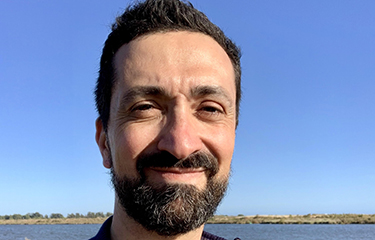Gonçalo Carvalho is the executive coordinator of Sciaena, a nongovernmental organization in Portugal that aims to promote a healthy marine environment through the promotion of sustainable ways of exploitation, the involvement of the population, and political intervention.
Can the Spanish and Portuguese historic swordfish fishery still have a place in the 21st century? Only if it embraces the changes and possibilities it presents.
Few marine species are as easily recognizable as the swordfish, with its pointed bill, elongated and streamlined body, wide crescent-shaped caudal fin, and dark skin. Its speed, strength, and keenness for acrobatic leaps high above the water have always left those at sea amazed but also with a great desire to engage in epic duels with this mythical fish. This relationship is so intense and turbulent that it inspired Hemingway to write one of the best and most famous books about the relationship between humans and the sea – The Old Man and the Sea.
The swordfish, scientifically known as Xiphias gladius, is what you could consider a "superfish," capable of regulating its body temperature, and reaching astonishing speeds and colossal sizes. It is also part of the so-called "great migrators," with vast stretches of open ocean – the pelagic zones – as its habitat, traveling thousands of kilometers to reproduce and satisfy its voracious appetite.
There are also few species in the Atlantic that have been so coveted and the target of fishing for so many decades, constituting part of the identity of communities in the Atlantic coast of the Iberian Peninsula, such as Vigo, Peniche, or Sesimbra, and thus leading to the creation of significant fleets of surface longline vessels, ships that use long lines with hundreds of baited hooks to capture this and other species.
Swordfish fishing in the Atlantic coast of Portugal and Spain intensified from the 1980s, reaching a historic peak of catches in the north Atlantic above 20,000 tons in 1987. However, like other historically caught species such as bluefin tuna or cod, swordfish suffered the impacts of prolonged overfishing and began to decline in the following years. Despite a slight recovery in recent years, the species still requires special attention, and the quantities that science advises as safe to catch are far from what was captured in the past. Inevitably, the fleet that targeted this species began to focus its efforts on other species, notably blue shark.
Currently, the management of swordfish fisheries in the Atlantic is carried out within the framework of the International Commission for the Conservation of Atlantic Tunas (ICCAT), the United Nations organization responsible for the management of large pelagic species in the Atlantic Ocean. The more than 50 members of ICCAT – including the European Union and thus Spain and Portugal – will gather for their annual meeting, this time in Cairo, between 13 and 20 November, where decisions will have to be made that can help swordfish fishing embrace sustainability and become one of the exemplary fisheries in the Atlantic.
First and foremost, a management procedure for North Atlantic swordfish may be approved. Management procedures can be considered "fishing management 2.0," as they increase the predictability and caution of scientific advice and incorporate conservation goals. ICCAT has been at the forefront in adopting these management measures, having adopted this measure for one of the most iconic stocks under its jurisdiction last year – North Atlantic bluefin tuna.
At this annual meeting, ICCAT will have to make another crucial decision, not only for the health of pelagic ecosystems in the Atlantic but also for the medium-term sustainability of the national longline fleet. After years of high catches, partly motivated by the decline of swordfish, blue shark populations urgently need lower catch limits to be established, in line with scientific recommendations.
Finally, the European Union and its member states must advocate for the strengthening of ICCAT provisions related to remote electronic monitoring, onboard observer coverage, and the harmonization of protocols that allow inspections at sea. Moreover, the recently approved revision of the EU's fishing control regulation aims to put European fleets on the path to digitization, traceability, and accountability, protecting fishermen and fleets that comply with the laws and follow scientific advice. With these measures approved and implemented, the industry and commercial operators can then reap the benefits, differentiating and adding value to their products.
Thus, the European Union and Spain and Portugal in particular, as well as the other countries that make up ICCAT have a unique opportunity in the coming weeks to prove that the fleets capturing swordfish and blue shark are fully committed to precautionary fisheries management and minimal impact on the health of marine ecosystems, as well as to transparency and full monitoring. Only then can it be demonstrated that swordfish fishing has a place in the 21st century.
Photo courtesy of Sciaena






